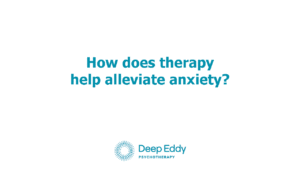Charlotte Howard, a therapist at Deep Eddy Psychotherapy in Austin, TX, talks about simple techniques that can be used to alleviate anxiety and how therapy helps train your parasympathetic nervous system to relax.
Anxiety is a Defense Against Feelings
Anxiety is often a defense against feelings. Often, we jump out of whatever our primary feeling is and into anxiety, instead. That can be just as unpleasant or more so than the actual feelings we were unconsciously trying to avoid! If you can access whatever the feeling underneath is, then the anxiety will relieve itself automatically. So, the most important way therapy helps with anxiety, in my opinion, is through the healing process of finding and exploring your underlying feelings.
Good Therapy Can Heal Anxiety
As I’ve stated, a lot of my clients have anxiety because they are defending against other feelings or have shut themselves down in some way that they aren’t aware of. Really what we’re doing in therapy is just trying to undo defenses and find out what they’re feeling so they can have that experience and care for it. Once the feeling is released, the anxiety really resolves naturally.
Therapeutic Techniques for Healing Anxiety
There are a lot of techniques for working with anxiety if you need a short-term band-aid. Ideally, we want to heal the deeper thing that’s causing the anxiety, underneath, but that’s a longer process. In the meantime, there’s relaxation training, which is like guided imagery. In guided imagery, you close your eyes and have someone guide you through a process that actually teaches your parasympathetic nervous system how to activate, which is called the relaxation response. Practicing relaxation makes it more and more automatic and easy to get to.
Learning to Train Your Nervous System
Practicing relaxation is about controlling flow. If a river bed is deeper in one area, then the water is going to flow in that direction more easily. The more the water flows that way, the deeper the river bed. Relaxation training is about practice, practice, practice because that heightens the chance our brain will go that direction by deepening that “river bed.” Then you can access it much more easily because your brain remembers how to do it, you’ve actually trained your nervous system.
Deep Breathing in Therapy
An important part of relaxation training, and relaxing in general, is deep breathing, which of course is very ancient–used in many traditions to relax. It gets underrated because people will say, “Oh, yeah, breathing—deep breathing,” and just brush it off. However, the reason it is so popular or well known is because it’s extremely effective.
Our breath responds to a threat before our mind even knows that there’s a threat. Your breath will become more shallow and faster, so the brain takes its cue from that, “Oh, shoot! The breath just changed! We’re in trouble!” and releases all the corresponding nervous system responses.
The cycle can work the other way, too. You slow down and then deepen your breath, then the brain says, “Oh, maybe we’re safe,” and then it spins the other way and relaxes, calms, and soothes your body.
Relaxation Training and Deep Breathing are just the beginning. We have many articles and posts on Mindfulness, which is a huge part of healing anxiety and of the therapeutic process.
Starting Therapy in Austin, TX
We would love to invite you to make a complimentary call to discuss some of your options and determine whether Deep Eddy Psychotherapy in Austin, TX is the right fit for you and your situation. Please contact us using the links below or in the sidebar and share this post or video if you found it to be valuable. Together we can create a world of well-being and joy.

